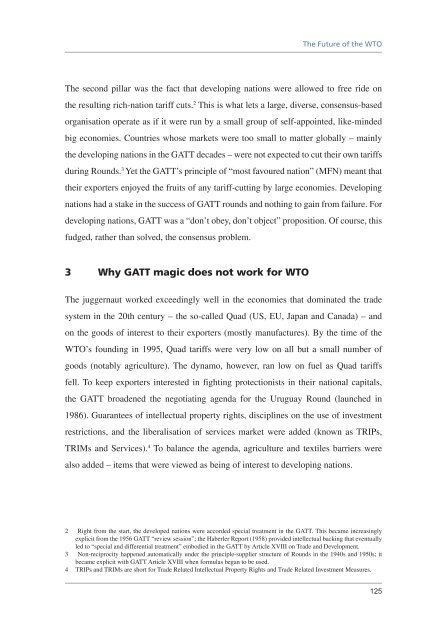Download PDF - Vox
Download PDF - Vox
Download PDF - Vox
- No tags were found...
You also want an ePaper? Increase the reach of your titles
YUMPU automatically turns print PDFs into web optimized ePapers that Google loves.
The Future of the WTOThe second pillar was the fact that developing nations were allowed to free ride onthe resulting rich-nation tariff cuts. 2 This is what lets a large, diverse, consensus-basedorganisation operate as if it were run by a small group of self-appointed, like-mindedbig economies. Countries whose markets were too small to matter globally – mainlythe developing nations in the GATT decades – were not expected to cut their own tariffsduring Rounds. 3 Yet the GATT’s principle of “most favoured nation” (MFN) meant thattheir exporters enjoyed the fruits of any tariff-cutting by large economies. Developingnations had a stake in the success of GATT rounds and nothing to gain from failure. Fordeveloping nations, GATT was a “don’t obey, don’t object” proposition. Of course, thisfudged, rather than solved, the consensus problem.3 Why GATT magic does not work for WTOThe juggernaut worked exceedingly well in the economies that dominated the tradesystem in the 20th century – the so-called Quad (US, EU, Japan and Canada) – andon the goods of interest to their exporters (mostly manufactures). By the time of theWTO’s founding in 1995, Quad tariffs were very low on all but a small number ofgoods (notably agriculture). The dynamo, however, ran low on fuel as Quad tariffsfell. To keep exporters interested in fighting protectionists in their national capitals,the GATT broadened the negotiating agenda for the Uruguay Round (launched in1986). Guarantees of intellectual property rights, disciplines on the use of investmentrestrictions, and the liberalisation of services market were added (known as TRIPs,TRIMs and Services). 4 To balance the agenda, agriculture and textiles barriers werealso added – items that were viewed as being of interest to developing nations.2 Right from the start, the developed nations were accorded special treatment in the GATT. This became increasinglyexplicit from the 1956 GATT “review session”; the Haberler Report (1958) provided intellectual backing that eventuallyled to “special and differential treatment” embodied in the GATT by Article XVIII on Trade and Development.3 Non-reciprocity happened automatically under the principle-supplier structure of Rounds in the 1940s and 1950s; itbecame explicit with GATT Article XVIII when formulas began to be used.4 TRIPs and TRIMs are short for Trade Related Intellectual Property Rights and Trade Related Investment Measures.125














